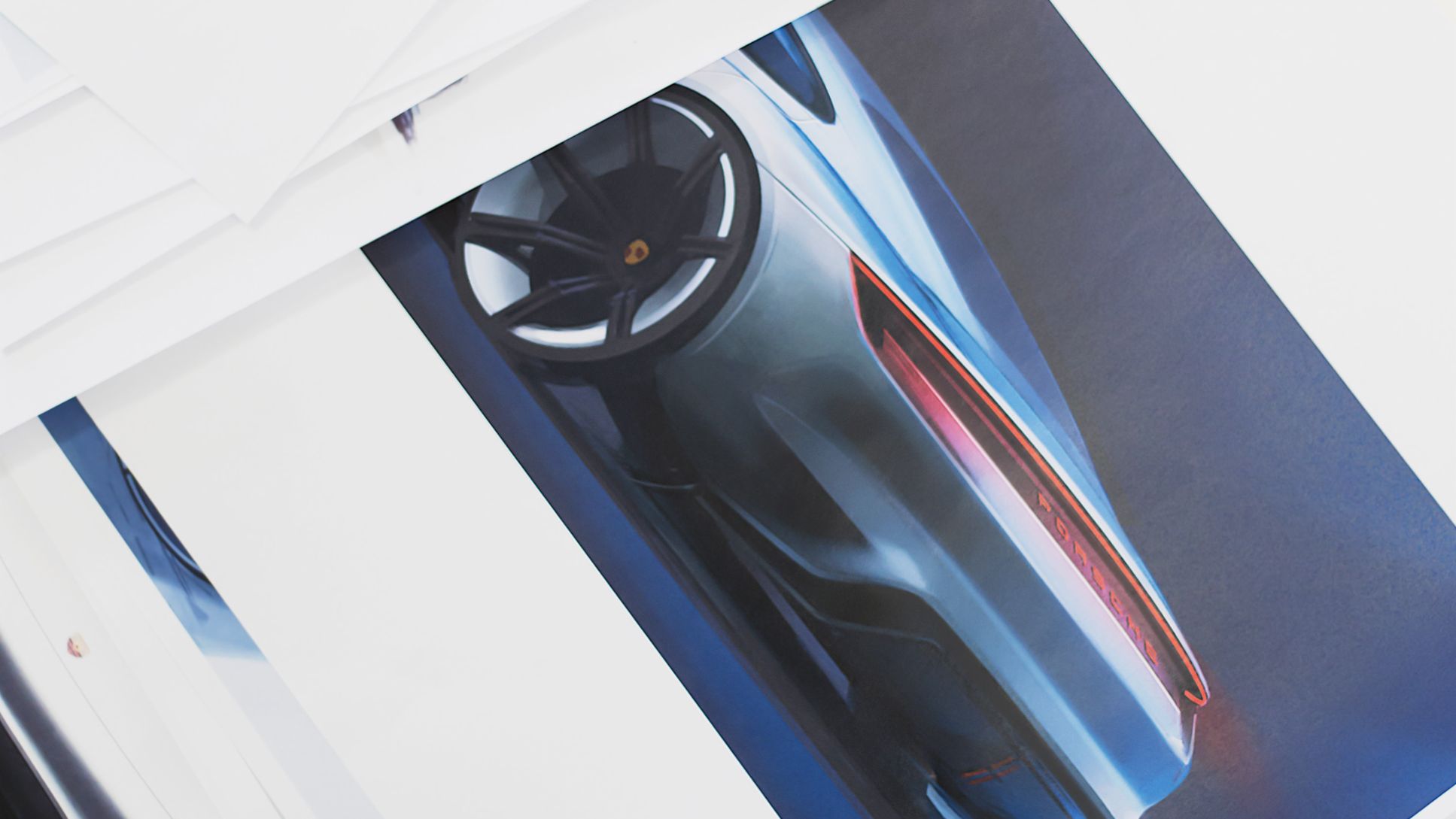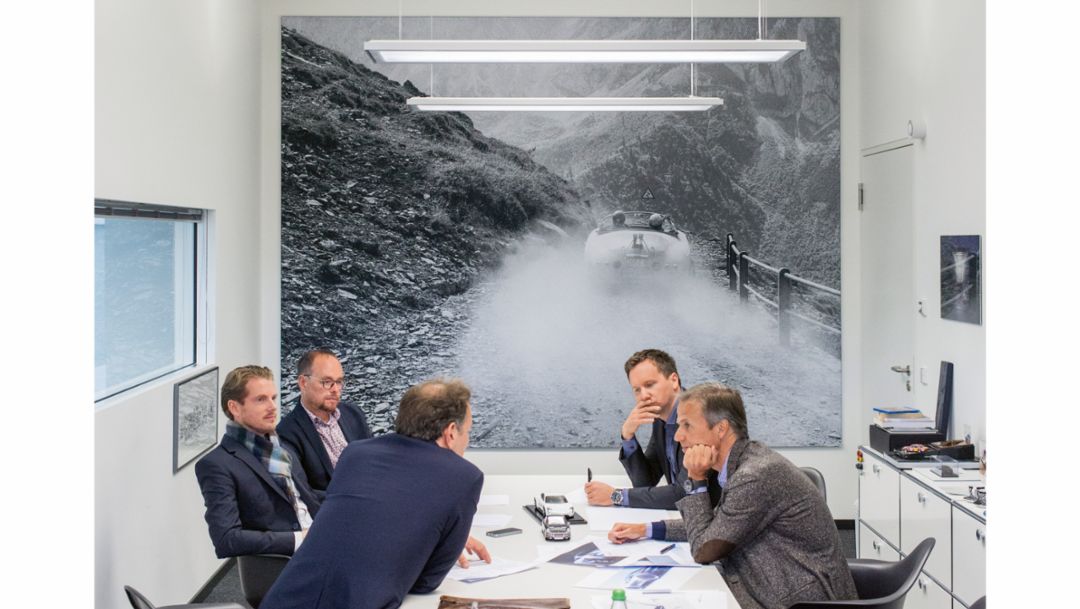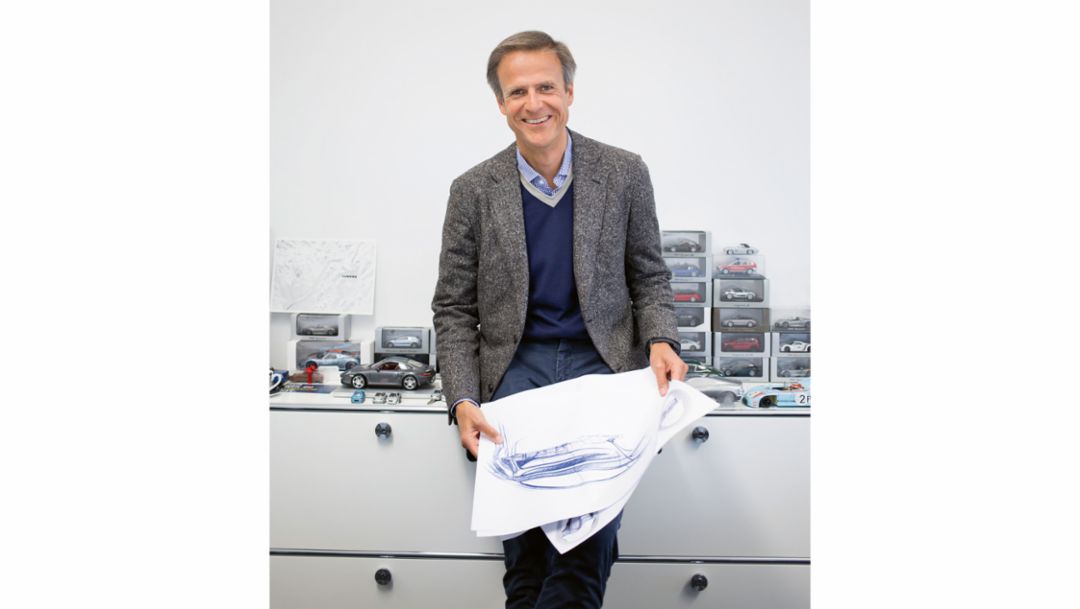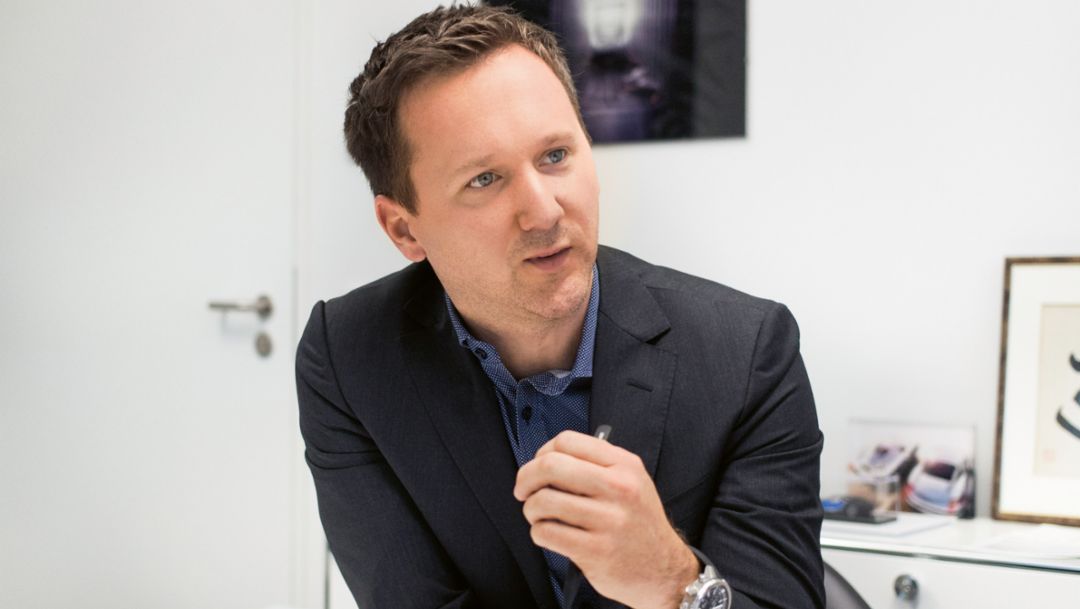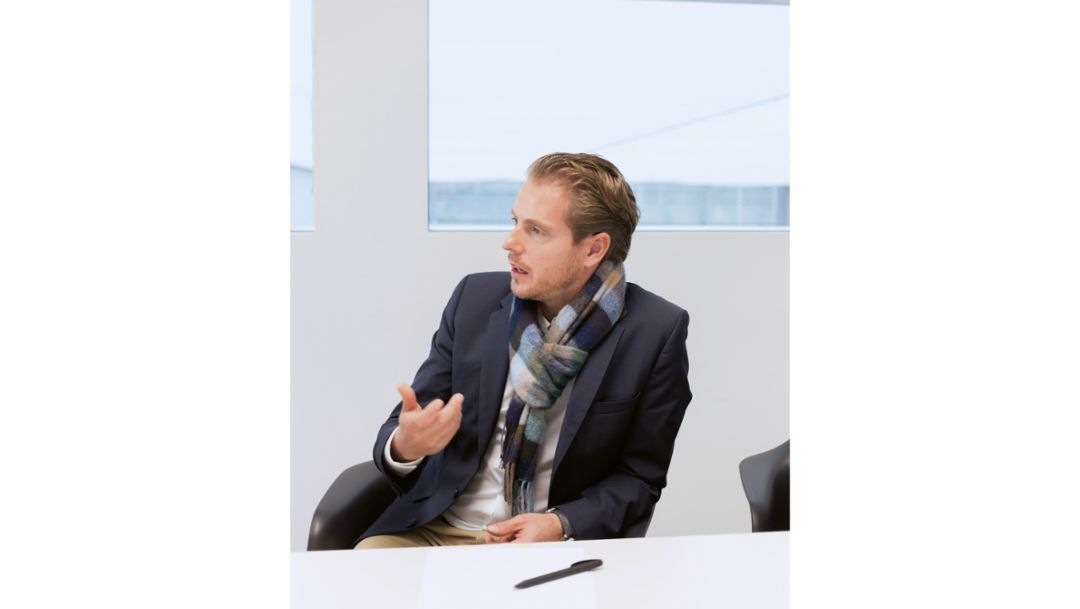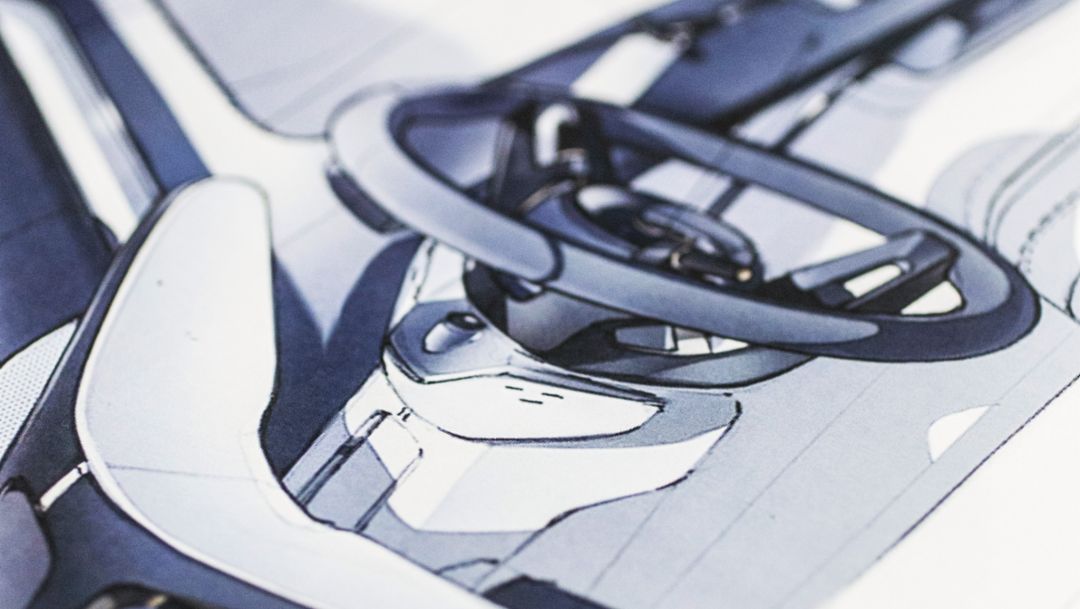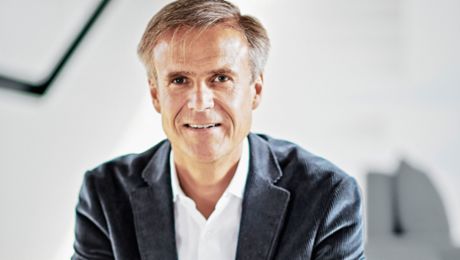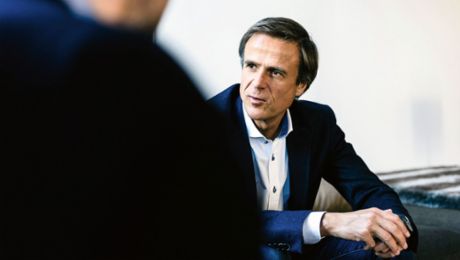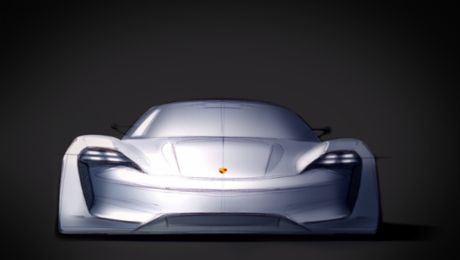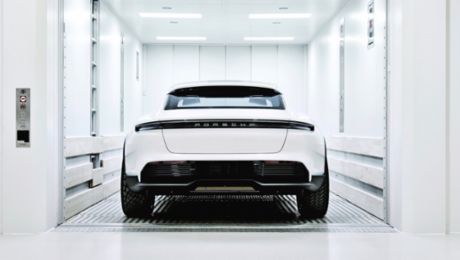When Michael Mauer looks up from his desk he does not see what a designer would normally see. He sees a cloud of dust. He sees mountains. He sees an exciting, unpaved road leading up one of these mountains with a Porsche 356 on it. What he sees is a photograph that covers the entire wall. It gives viewers the impression that they are looking directly into a bygone world in which what we call the Porsche DNA was born – the core of the brand, what Porsche stands for, what leaps to mind upon hearing the name of the brand. What one sees in this photo is what one normally does with a sports car. It is something one has done – or has been able to do – with a Porsche for as long as Porsche has existed. Because, since the first 356 hit the roads in 1948, customers have been delighted not only with the car’s beautiful and soon-to-be classic streamlined form, and not only with the precise ways its technology determines its form, but also with its ability to engage in all manner of adventures.
The photo is a brilliant image in a technical sense, for the Porsche appears here not only as a sports car with an appealing form but also as a vehicle that does not shy away from any adventure, from any snow-covered track that might enable the world to be experienced in different and more intensive ways and that might also encourage its driver to set off on roads less travelled – in contrast to other sports cars that only run on smooth and dry paved surfaces. Right from the beginning, design at Porsche has always meant more than shaping a product. It has also meant facilitating a lifestyle that delights in experimentation and occasionally sends one off on snow-covered dirt roads.
The photo in Mauer’s office, which was taken in the 1950s, also captures a moment in history. Today, nearly all roads are paved, and many other things have changed as well – and will continue to change all the more. Digitalisation, electrification and connectivity mean that cars are facing the greatest transformation in their history. These are exciting times of unprecedented upheaval. Cars will have different drive systems, they will send each other signals and they will feel different to drive. Over the long term, combustion engines – whether mounted in the front, in the middle, or at the rear – will become the exception. What does that mean for a brand whose fame is due also and especially to its engines? How will new drive technologies change its design? The layout of electric cars will become ever more uniform, and more skeletal – with short overhangs, four large wheels and an elongated domed section between them for the batteries and the occupants. How will Porsche resist this tendency to become uniform? What are the adventures, the dirt roads of the future on which one can have new and intense experiences? And how can engineers and designers translate that which constitutes the core of the brand and its legend into a new form, while skirting the new ideological, technological and political crash barriers of the future?
The prospects of an electric future don’t seem to be triggering panic at the Porsche Development Centre in Weissach. On the contrary. The four men sitting there seem pretty electrified themselves by the tasks entrusted to them. They are Michael Mauer, Porsche’s Chief Designer who also became Volkswagen AG’s Head of Design in 2016; Matthias Kulla, Porsche’s Head of Sports Car Design Project Coordination; and two young leaders at Porsche Design: Peter Varga, Director Exterior Design, who was born in Hungary in 1978, and Ivo van Hulten, Director Interior Design, who was born in the Dutch town of Waalwijk in 1977. This morning, as the first still-camouflaged Mission E models do laps through the fog that blankets the woods and meadows of the South German Scarplands, Mauer asks: “What does the sports-car experience as we know it today actually consist of? Does the sound account for 90 per cent of it, or just ten per cent? In any case, a sports car is more than the sound it generates. There is acceleration, there are G forces, there is the way it turns corners. Yes, Porsche is famous for its engines – but not for them alone. We have to think about how we will carry what constitutes our brand into the future. If I have an electric drive, that doesn’t mean that I cannot expand on its emotional qualities. The car that we are developing right now will not have a combustion engine, but it will be one thousand per cent Porsche in everything else. And for that matter – an electric car does have acoustics!”
But how does one develop a thousand-per cent sports car? What can be changed, what must remain? Weissach already had to grapple with these questions before the electric revolution. When informed that a new Porsche 911 will soon be coming onto the market, fans of the brand react like people have always done when their spouses tell them they wish to try out a new hairstyle – with a mixture of curiosity, suspense and trepidation. Then, upon seeing the car for the first time, they walk around it excitedly to check whether all the important features are still there: the elliptical side windows, the ignition to the left of the steering wheel, the tachometer in the centre ...
Porsche designers have a profession comparable to that of Greek temple builders. The familiar form with its pillars and tympanum has to remain, and the art lies in modifying the original type so as to give it surprising new proportions and adapt it to changing needs and circumstances. How do designers maintain a balance between the challenge of addressing new situations and the wish to retain the classical features that determine identity? At a time when the engine of an electric Porsche can no longer be the defining feature that it was in the era of its flat-six counterparts, the design becomes the main foundation for the brand’s identity and what reassures employees and everyone who builds Porsches that they are preserving a legend which is also an economic success. How do designers deal with the now more prominent role of design? And if design is more than the art of giving an object an aesthetically pleasing exterior, what will Porsche design have to address in the future?
“You can take what makes a Porsche an object of desire, or a sports car in general for that matter, and divide it into two categories,” says Matthias Kulla. “There is something almost archaic that we are born with, and something acquired that can change over time. The sound is an example of something acquired. We associate sports cars with high-powered engines these days, and we associate these engines with an appreciable volume. This does not always have to be the case. For example, it used to be considered more masculine to drive a car with a non-synchronous transmission – and no one is interested in that anymore. But then there is something fundamental that doesn’t change. That is the urge to get places on your own terms and volition, including in adventurous ways if you so desire. What we do here is study and facilitate this urge – I determine where I go – that underlies everything we’ve acquired.” A lot of that consists of examining our usual ways of seeing and hearing things. Compared to its contemporaries in the early 1970s, a Porsche was impressively broad, and its bellows-like bumpers gave it a brawny appearance. The same car today looks slim, delicate, and almost shy when compared to the considerably more powerful rear of a current 911. Form can undergo enormous change in its evolution. What is important, say the designers, is to preserve the essence.
Porsches have always demanded presence of mind from their drivers “who consciously desire to experience the car,” as Mauer puts it. “Many people see a contradiction between driver assistance systems on the one hand, and the desire to be not just a passenger in one’s own car but rather to intensively experience the act of driving it. But my question here would be how to put systems like the head-up display, whose original function is to enhance safety and comfort, to different uses, for example on a racing track by superimposing the racing line. Innovation often consists largely of reconceiving and recombining things that already exist.” The steering wheel will not be removed from the hands of the driver, says Mauer. “Level 5 of autonomous driving – which is being driven in a car without a steering wheel – is not the future for Porsche. The person in the car always has to have the power to make decisions. Driver assistance systems are welcome in congested traffic, but their main purpose should be to support the activity of driving. And our drivers may decide whether or not to activate these systems, more so than they would with other brands. These are details, but they are also the building blocks of brand identity.” Design has long been more than creating an appealing form. It has come to mean shaping the entire brand. “There are things we are expected to do,” says Mauer. “Connectivity and butler services are very clear qualifiers for our brand. But if the business saloons of other brands select smooth and straight roads, our product will propose a road that’s fun to drive. The nature of what’s on offer has to fit the brand – that too is part of what it means to build a brand.”
Porsche has become a product family with sports cars, sports saloons, roadsters and all-terrain vehicles, and will soon have e-cars as well. This presents the designers with new tasks. Mauer distinguishes between brand identity and product identity. All the cars have to be recognizable as Porsches. A certain physique – the flared hips, the window lines – is part of the family resemblance, whereas the product identity is expressed by elements such as different headlights – a Macan has different “eyes” than a 911. The scope that product designers can explore between the wish for comfort and safety on the one hand, and the desire for freedom, intensity and self-determination on the other, is reflected in the current range of models that includes a Panamera with all the driver assistance systems as well as a 911R which only comes with manual transmission.
What does the magic of a manual transmission stand for? For direct and immediate communication, for a synthesis of the human body and the car. Porsches – especially the open roadsters and convertibles – have always been machines that allow one to experience the elemental forces of the wind and sun, as well as speed and steering power, more intensively. “But this type of experience – the streamlined, direct, effortless qualities that make up a Porsche – is possible every bit as much or more with an electric motor,” says Mauer. As Ivo van Hulten adds, “It is very important to recall the past, but it’s also important to ask how I can make this experience more modern and even better, and to intensify it.” But if the aim is to intensify the Porsche feeling, then one first has to know what that feeling consists of. What exactly goes into it? “You shouldn’t overwork the product,” says Peter Varga. “You should maintain an emphasis on functionality, and design a car that can also serve everyday purposes, one that is not a centimetre too long or too wide, and that also fits in an underground garage. You can make every Porsche more extreme or more expressive – but the key to the brand is its confident, self-contained presence.” In 1963, Porsche put perhaps its first classic car with clear and unadorned lines on the road with the 911. It was the antithesis of the shark-fin excesses and rounded automotive baroque of the 1950s. The Porsche 911 was introduced in the same year in which legendary designer Dieter Rams presented his Braun T1000 shortwave receiver and Mies van der Rohe his design for the New National Gallery in Berlin. All three designs are characterised by spare and exacting lines. Today the car is considered the epitome of classic German automotive design, an engineering work of art that has no place for anything superfluous.
Yet one shouldn’t get the wrong idea. The Porsche 911 had what other examples of the somewhat dry Bauhaus aesthetic often did not, namely a very un-Germanic high-speed hedonism. The 911’s greenhouse, the cabin and its elliptical side windows show such vigour that one pictures the designer’s pencil itself heading off for the race track – without ever crossing the line from dynamism to an overexcitability that would compromise the form. In formal aesthetic terms, a Porsche is always a complex entity whose vibrancy lies in an intensification of opposites. This is immediately evident upon viewing the rear of the current 911, whose tail lights are an homage to the subtle rear lights of the original 911. What you see is a finely structured and almost slender form that is also physically fit and powerful. Moreover, the current 911 highlights the essence of its construction more clearly: its hunched form, the concentrated power in the rear engine – its “nine-elevenness.” As if under high voltage, the lines converge between the broad hips of the fenders where the car’s centre of power is located, while the air inlets above the engine cast striking furrows. By contrast, the front is dominated by a calm, wide, empty space between the headlights that are now set further apart. Satori (the Asian art of emptiness) in the front, coupled with rock ’n’ roll in the back: the design expresses the unique constructive features of the rear-engine car.
Does this translation of driving experience find its form in the Mission E as well? For one thing, all four wheels are extremely accentuated – with the passenger compartment seeming to duck down between them. Then there is the geometry of the headlights, which, as mentioned above, clearly reflects the product identity. Where expansive, glass-covered headlights are usually located, the Mission E has slits that rise from the bumper, serve partly as wind inlets and become headlights at the top. This translates the soundless speed – like the wind – of the electric drive into the front visuals while also emphasizing the fact that, contrary to what one might think, cooling plays as much or more of a role in electric cars than in those with combustion engines. And even the windscreen itself enables a new driving experience. “When there’s nothing left in the front, you can lower the base of the windscreen like the Lamborghini Miura,” says Kulla. “The car was only 1.03 metres high, but you still looked out onto the bonnet. That was sensational. That changes your perception of the surroundings, they come into the car. The slender A-pillars also bring the outside closer and make everything more open.” And the car also seems to sit closer to the road, which would be a new way to intensify the driving experience that is so important to the Porsche developers. The Mission E could then also reverse a trend that has thus far seemed like a one-way street: the fact that car windows have become ever more slit-like and enormous sliding glass tops are meant to counteract claustrophobia in what would otherwise be grottos on wheels.
But might a new car end up being too futuristic? “The question is always one of how far you can go,” says Mauer. “Everything that happens here is a wager with the future. The fashion industry is designing things today that will be shown in three months. But for us, at least two or three years will go by before the presentation, and the car will spend another five to ten years – or much longer for a Porsche – on the roads. As designers we therefore have to throw our stone way out ahead. But if I throw it so far that no one will find it, I might have created a fantastic ground-breaking product that people will need another 40 years to understand – which doesn’t exactly help the company. We have to take people on board whose mode of perception changes only gradually.” That is why Porsche takes something like an evolutionary approach. “When someone comes to Porsche, they’re not about to start a revolution,” remarks Kulla. In the team’s day-to-day work, there are always “a few sketches that you’d say would make a great Lamborghini.” But the designers practise the art of discretion and reserve. “The proportions have to work,” is Mauer’s summary of the task. “We start by looking at how the car stands on the road. Then we consider questions of brand identity, followed by product identity, and then finally get down to the details – and a reserved quality in the visuals is part of this identity.”
“Special effects are not what give you iconic design,” says Varga. “That’s not something you can plan, nor do we have to. We have a brand that has developed such a strong identity that we do not need to make any radical breaks. The design of the first 911 was not radical either, by the way. The 356 was further developed and brought into higher relief, but the 911 had round headlights like a lot of cars. The form itself was not all that new, but rather the combination of performance, harmonious form and everyday usability. The conjunction of those things was what produced an iconic, classic car.” How will a 911 look next to the hypermodern Mission E? Upon being asked this question, Mauer laughs and remarks that at some point the 911 might be like a racehorse. “It could seem obsolete to some people as a means of transportation – but it’s unbeatable when it comes to evoking emotion.”
This emotional quality cannot be achieved by capricious changes to the form. Porsche’s design department has opted for calm in reaction to an ever-greater clamour from the radiator grilles. Whereas other brands are expanding their radiators as if the cars consume deer in a single gulp or stare down the road like monsters from the deep, Porsche seeks concentration, reserve and no more lines or shapes than necessary and appropriate. “At a time when video clips and movies are using faster cuts to generate ever more hectic action, I love watching old films with their incredible sense of duration,” says Mauer. “They evince a high art of concentration, engagement and precision. And omitting everything that’s not necessary gives them enormous freedom.”
Yet form, like the timbre of a beautiful female voice, also needs to command a few dark and smoky tones. The front visuals of a Porsche have traditionally not been designed to intimidate or startle other users of the road, but rather with a type of social compatibility in mind. Beetle drivers need not feel humiliated when a 911 appears in their rear-view mirror – it is simply a faster relative, not something that aims to disparage or push others aside. A Porsche has its roots in popular culture, its ancestor is closely related in both construction and aesthetics to the Volkswagen Beetle. Is this proximity also part of the reason why Porsches are the sports cars that enjoy the highest level of social acceptance? This ethic of reserve and accessibility – despite all the exclusivity of the product – is an “essential component of the brand identity,” says Mauer. “If you want to make a loud splash – both visually and acoustically – a Porsche is not the right brand.”
As Kulla explains, “Every person lives intuitively in such a way as to have many moments of happiness. And feeling good is also one of the criteria when deciding which car to buy. Will I feel good if my car needs 20 litres of fuel to go 100 kilometres? A Mission E gives me a driving experience that’s dynamic in the extreme – yet it also gives me the satisfaction of buying something reasonable, responsible and socially acceptable.” The history of Porsche has always been one of interplay between technological and social developments. “There has always been a high need for safety, and this will continue to be the case,” says Mauer. “People seek protection in environments where risks are constantly on the rise.” Lawmakers often influence design more intensively than one might think. “First there were safety belts,” says van Hulten, “then there were the requirements for the front hood in case the cars happened to hit pedestrians.” Cars were no longer designed from a best-case but rather a worst-case perspective, and the presence of many details has to do with preparations for a possible crash. Every car carries hundreds of kilos of safety technology around with it in case it collides with something. “But when one day cars are so connected that they detect and communicate with each other and collisions become unlikely, that will give design a totally new freedom and lightness,” says van Hulten. “That will liberate design as well. We won’t even need traffic lights. Cars will be able to shed their armour.”
As we move towards that point, the boundaries between engineering and design are becoming increasingly fuzzy. The “emphatic expertise” of designers can contribute to this process in key ways, says Mauer. An initial product of this new age will be the Mission E, which customers will not find to be lacking in any way, he promises. “With the exception of the engine sound, this product has everything that makes a Porsche – and new things customers don’t even know yet that they’ll love.” The designers’ relaxed attitude to the electrification of an object many people love for its sound might have something to do with the fact that company founder Ferdinand Porsche built electric cars an entire century before Silicon Valley even thought about doing so. He developed the electric “Voiturette Lohner-Porsche” for the Viennese carriage maker Ludwig Lohner. Powered by two internal-pole electric motors in the front wheel hubs, it came onto the market in 1900. Lohner thought that combustion engines were too dirty to survive for long, and that electric cars were the way of the future. Shortly after 1900, Ferdinand Porsche developed this vehicle further into a sports car – just like he would later develop the Beetle into the Porsche. He gave it four wheel-hub motors instead of two, which meant he also put the first car with all-wheel drive onto the road, and promptly won the Semmering race with it. Electric motors, all-wheel drive – the new Porsche Mission E blends the past with the future in a very special way. It not only anticipates the future of the brand, but is also deeply rooted in more than a century of history. Back then the name of Porsche already stood for a vision – incredible at the time – of driving with electric power. Some ideas simply have to mature before they can take on form. Their time now seems to have come.
Info
Michael Mauer (born 1962) studied Transportation Design at Pforzheim Technical College and began his career in 1986 as an exterior designer at Mercedes Benz AG. In 1988, he became Head of the Mercedes-Benz Advanced Design Studio in Japan. A year later, Mauer took over as Head of Design at MCC Smart. In 2000, he moved to Saab as Executive Director of Design. Michael Mauer has been Head Designer at Porsche AG since 2004. At the end of 2015, he was also appointed Head of the Design division at the Volkswagen Group.
Matthias Kulla (born 1962) studied Automotive Design at the Royal College of Art in London and has been working as a designer for Porsche since 1989. His first major project was the Porsche 989 prototype. From 2005 to 2014, he was responsible for the exterior design of all the product lines. Kulla is now in charge of Design Management for sports cars.
Peter Varga (born 1978) has been Head of Exterior Design at Porsche since 2016. Born in Hungary, Varga graduated from Pforzheim Technical College in Transportation Design. He has been working as a designer for Porsche since 2014. The current styling of the Panamera, the 718 product line and the 911 Carrera all come under his responsibility.
Ivo van Hulten (born 1977) studied Industrial Design at the Design Academy in Eindhoven. Born in the Netherlands, he started his career in 2003 at Audi AG. He was then Head Designer at GM Europe Design Opel in Rüsselheim for several years. Van Hulten has been Head of Interior Design at Porsche since 2014.
Niklas Maak (born1972) studied philosophy and architecture in Hamburg and Paris. He wrote his doctoral dissertation on design theory in art history. Today he is the Arts Editor of the Frankfurter Allgemeine Zeitung, and also teaches architectural theory as a guest professor at Harvard. He has received numerous awards for his essays and books, including the Henri Nannen Prize, COR Prize, Kennan Award and the Critics’ Award (Kritikerpreis) from the Association of German Architects (BDA).
Text first published in the Annual & Sustainability Report 2017 of Porsche AG.
Text by Niklas Maak // Photography: Elias Hassos
